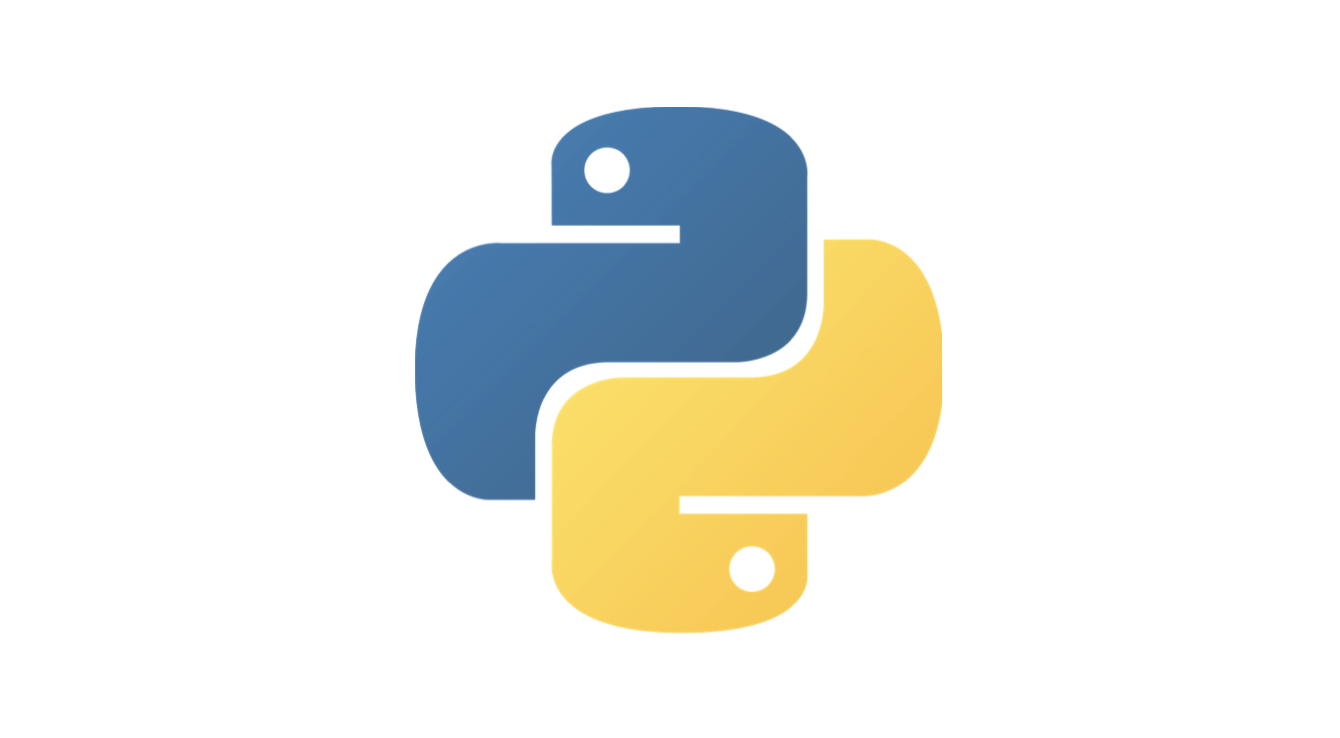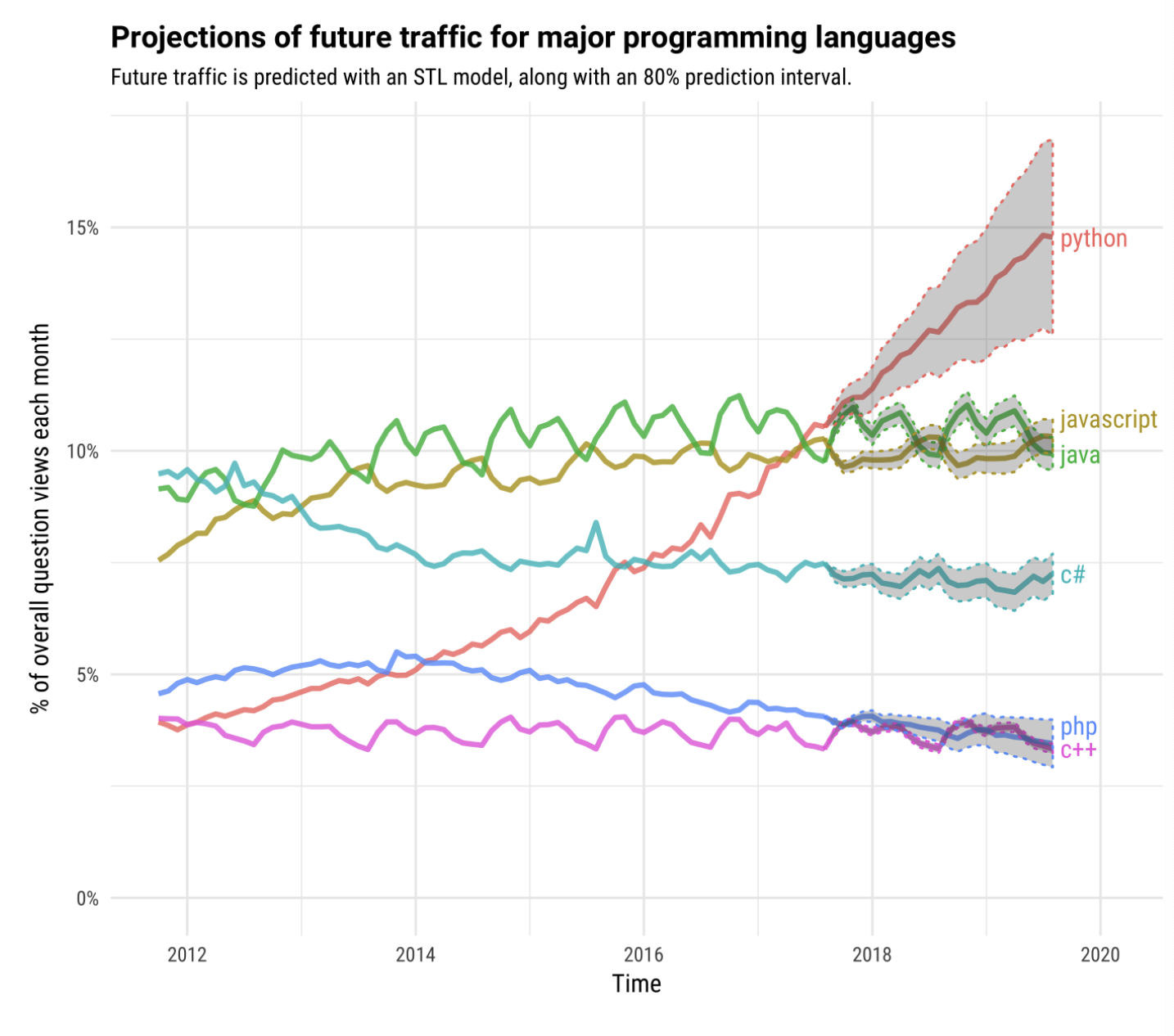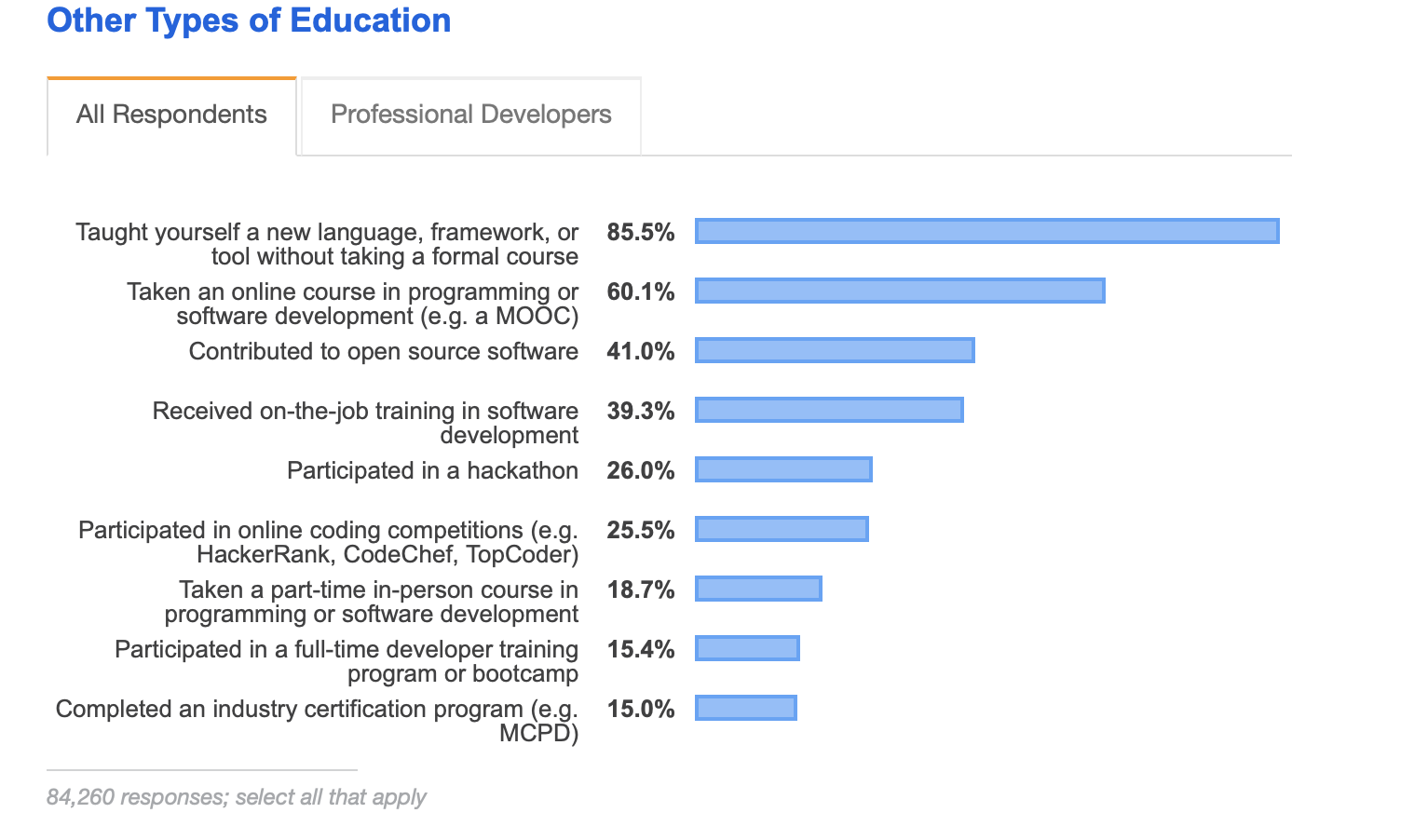Table of Contents
Software developer trends to keep an eye on in 2024 and beyond
The new decade is upon us, and with it comes a flood of excitement for the changes and trends we will see in tech.
Software development has become more integral to nearly every sector of the world, so the developments and changes in software development have a vast impact on our lives. While we cannot always accurately predict what lies ahead for tech, there are some trends that we expect to continue into the new decade.
Let’s discuss 8 software development trends that we expect to see in 2020 and beyond.
Ride the ML revolution with Python
Learn to use Python to develop artificial intelligence and other modern marvels.
Python Data Analysis and Visualization
1. Artificial Intelligence will continue to dominate#
Though Artificial Intelligence has been around for many years, it continues to grow and enhance every year as it becomes more foundational to many technologies around the world. Developers predict that AI will continue to dominate as more and more industries adopt AI in their infrastructures.
The biggest trends for 2020 suggest that healthcare, education, travel industries, and social media will utilize AI for personalized experiences, assistance, and prediction services.
AI will be the new competitive edge for industries across the spectrum, changing the way we think about human involvement and resources. The Deep Learning framework Tensorflow 2.0 is predicted to dominate the market.
2. Python predicted to rise alongside AI and ML developments#
From ML research to video game development to web development, Python consistently proves a popular and well-loved language. Since ML and AI development is on the rise, Python is predicted to continue in this steady growth and popularity, particularly for impressive innovations including ML-powered chatbots.
Though the concept of the “fastest-growing” language can be hard to pin down, data suggests that Python may just take the cake. Not only is Python used for a variety of popular fields and jobs, but it also has a low entry barrier and supportive community fostered by the newest generation of developers.
3. 5G: The next big thing in mobile development#
5G enters the market in 2020, and this exciting, faster network brings with it new problems, good and bad, for developers to solve. Despite the drawback and controversies, 5G has the potential to revolutionize handheld devices and open the doors for developers to get in on the ground floor of distributed technologies. It offers the chance for developers to work on more robust applications and augmented reality features.
Overall, 5G is predicted to transform the world, from powering smart cities to improving traffic systems to increased capacity for network expansion.
Of course, the processing power of 5G brings with it concerns that developers also need to address, such as the recent concerns for weather prediction technologies or complaints around poor coverage. Regardless of the challenges ahead, the technology is promising and worth the investment.
4. Edge and Cloud computing predicted to rise#
Alongside 5G comes the promise of Edge computing, a distributed computing infrastructure.
The highly distributed model of Edge computing (sometimes called fog computing) may help to overcome the disadvantages of cloud computing. These developments may be the future of computation and industry. Cloud computing proves vital to company infrastructures, and as cybersecurity concerns persist, large companies across all industries move towards the Cloud as a solution.
On top of that, the worldwide public cloud service revenue is forecasted to rise from 227.8 billion US dollars to 266.4 billion by the end of 2020.
Edge computing is predicted to be on the rise as an upgrade to cloud computing capabilities. In fact, the worldwide Edge computing market is predicted to rise from 1.47 billion USD in 2018 to 26.84 billion USD by 2025.
Keep developing the future.#
Python and data analytics continue to dominate the modern tech market. Master both to meet employer demands of tomorrow.
5. Trending languages: Rust, TypeScript, Kotlin, and Swift#
Over the past decade, hundreds of programming languages have been created for developers around the world.
This shift away from the monolithic languages of the past enables developers to work with specialized languages that focus more on developer ergonomics and modernized developments in hardware. The sheer variety of programming languages empowers developers, strengthens the industry, and turns our focus towards solving human problems.
StackOverflow research suggests that the top 4 modern programming languages to rise in 2020 are Rust, TypeScript, Kotlin, and Swift, with Rust taking 4th position for the last four years consecutively.
6. Kubernetes emerges as the victor over Mesos and Docker Swarm#
Along with the rise of Cloud computing comes the rise of containerization applications, and Kubernetes has emerged as the clear winner. As cloud technologies continue to integrate with our world, Kubernetes will be an important tool for developers everywhere. Research shows that Kubernetes popularity continues to rise.
Developers predict that in 2020, we will see a rise in best practices and standardization of this widely-popular application.
7. Web frameworks: React continues to shine through#

It has shown to be the most dominant JavaScript Web Framework in the past year, and the stats suggest that this will continue in years to come.
Though other frameworks like Vue do offer their own unique capabilities, React is preferred by many due to its flexibility and robustness. And since React is backed by Facebook, it will only continue to rise in the industry as a standard for web development. Take a look at these Google Trends to see how far ahead React is in worldwide interest since 2017.
8. Self-taught programmers on the rise#
Despite the common perception of the tech industry, there is a gap in supply-demand for software development. And as the price of university rises across the globe, fewer people are turning to expensive degrees in Computer Science. Bootcamp graduate developers may soon be the norm.
The entry barrier for software developers is predicted to lower in the next few years to make space for self-taught developers.
On top of that, some developers predict that there will be an increase in LCNC development (low-code, no-code development) for enterprises to innovate without the need for CS degree-holding programmers.
Online learning platforms are one reason why the industry is shifting. Educative provides university-level courses for developers of all levels to level-up their coding skills and tackle new languages at a low, stress-free cost.
The goal for 2020 is to empower people around the world to join the world of development without the financial burden of university.
GenAI and AI-assisted development#
AI isn’t just a trend anymore — it’s redefining how developers build software. Large language models (LLMs) like GPT-4, Claude, and Gemini are now embedded directly into development workflows, and AI pair programmers like GitHub Copilot and Amazon CodeWhisperer are boosting productivity across the board.
-
AI as a coding partner: Developers now generate boilerplate, tests, and even full microservices with AI assistance.
-
Prompt engineering as a skill: Knowing how to “talk” to AI effectively is becoming just as important as knowing a language syntax.
-
New development practices: Teams are establishing guidelines for reviewing AI-generated code, mitigating bias, and handling sensitive data.
AI isn’t replacing developers — it’s amplifying them. The best engineers are those who know how to build with AI, not just around it.
Vector databases and LLMOps infrastructure#
As applications shift toward retrieval-augmented generation (RAG) and intelligent search, traditional data storage is no longer enough. Vector databases like Pinecone, Weaviate, and Milvus — along with extensions like pgvector for PostgreSQL and MongoDB’s Atlas Vector Search — are becoming foundational components in modern AI architectures.
-
Storing embeddings: Applications now rely on vector stores for similarity search, recommendation systems, and semantic retrieval.
-
LLMOps pipelines: Model deployment, prompt versioning, and monitoring are emerging as new disciplines.
-
Hybrid stacks: Developers increasingly combine relational, NoSQL, and vector databases to support AI-native applications.
Building modern apps now requires understanding not just backend logic, but also the data layer that powers intelligent behavior.
Developer experience (DevEx) takes center stage#
With growing complexity in infrastructure, languages, and tools, organizations are investing heavily in Developer Experience (DevEx). The focus is shifting from just “shipping features” to building workflows that enable developers to be effective and creative.
-
Internal developer platforms (IDPs): Teams are building self-service platforms that abstract away infrastructure complexity.
-
Faster feedback loops: Improved CI/CD pipelines, automated testing, and real-time observability tools reduce iteration time.
-
Measuring developer productivity: Metrics like flow efficiency, cognitive load, and deployment frequency are now key business indicators.
The best engineering organizations of today are the ones that treat developer happiness as a strategic priority.
Platform engineering and the rise of IDPs#
Kubernetes is no longer the endgame — it’s the foundation. As infrastructure has become more complex, companies are creating internal developer platforms (IDPs) that package infrastructure, CI/CD, monitoring, and security into unified, developer-friendly layers.
-
Abstraction of complexity: Developers can deploy code without worrying about YAML files or Kubernetes manifests.
-
Golden paths: Predefined workflows help teams follow best practices without reinventing the wheel.
-
Improved collaboration: Platform teams and feature teams now work together to improve delivery velocity and reliability.
Platform engineering is becoming a core competency, especially for organizations scaling their engineering operations.
Modern web platforms and runtimes#
The web development landscape has transformed dramatically. While React remains a top choice, the rise of meta-frameworks and new runtimes is changing how teams build scalable frontends.
-
Next.js and React Server Components: These patterns allow developers to build faster, SEO-friendly apps with less client-side complexity.
-
Alternative frameworks: Svelte, Solid, and Qwik are pushing the boundaries of performance and developer ergonomics.
-
New runtimes: Tools like Bun and Deno are introducing faster, more lightweight alternatives to Node.js.
Web development is no longer about choosing a library — it’s about picking the right platform stack for scalability, speed, and developer experience.
Security, governance, and FinOps#
In 2020, security was a checklist item. Today, it’s a competitive differentiator. With increasingly complex supply chains, multi-cloud architectures, and compliance demands, security and cost governance have moved to the forefront of software development.
-
Supply chain security: SBOMs (Software Bills of Materials) and SLSA standards are becoming mandatory in enterprise environments.
-
Cloud cost optimization (FinOps): Engineers now collaborate with finance teams to build cost-aware architectures.
-
Privacy and data sovereignty: Global regulations (GDPR, CCPA, AI Act) are influencing how software is designed and deployed.
Security and governance are no longer just the security team’s problem — they’re part of every developer’s job.
What’s next?#
The world of tech is always changing, with each development rippling across all parts of our society.
As a developer, you’re the one who’ll help push us to the wonders of the next decade. That’ll require you to keep up-to-date on the latest in developing trends.
As always, Educative is here to help and to help you reskill for tomorrows skills.
Happy learning!







